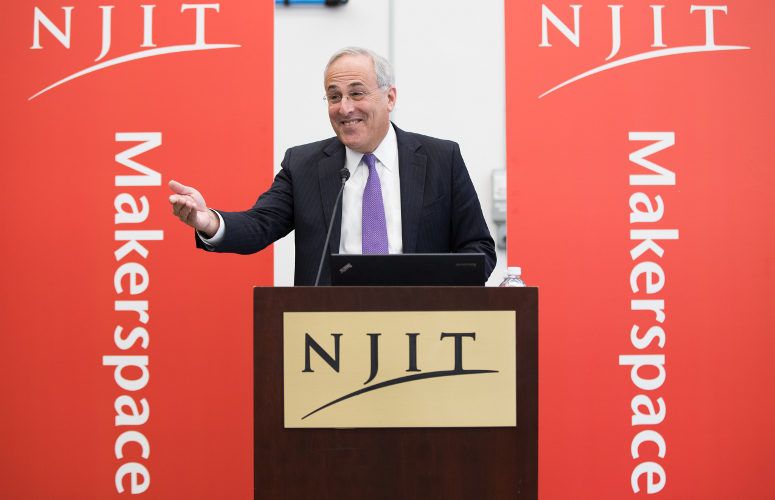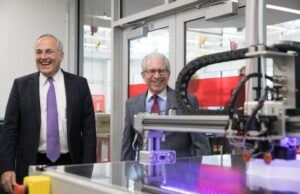
Is the Time Right for Corporate and University Partnerships?
On Feb 21, 2020Disclaimer: Sponsored content articles do not reflect the opinions of New Jersey Business magazine or the New Jersey Business & Industry Association.
Companies are watching transformative technologies move fast. These are complex technologies that are needed to compete and to innovate across industry verticals. The current workforce does not have years of experience and companies have not developed a full competency to be able to excel at these technologies. But to compete they must also be able to move fast. Companies want to be more efficient and bring products to market faster, solve real needs and drive the economy. Industry is motivated to look where the talent and expertise is.
It isn’t always in the companies themselves but both can be found at a university, in particular, a polytechnic. It used to be that corporations knew very little about what a university relationship could provide and to what extent it could be beneficial. The perspective from industry was that universities could be difficult to initially engage, that the contracting or collaboration process was lengthy and required too much legal interaction, the output on a project objective was slow, and often the biggest issue was who owns the intellectual property. Companies did not know what the capabilities of the universities were and had little knowledge about the quality and specialized focus of their faculty and laboratories.
Similarly, universities were not organized in a way to facilitate corporate contact and they were not structured in a way to assure oversight to the company-university relationship. Most companies in the past had a negative view of working with academia from a poor time-to-deliver perspective. There was no single point of contact and no robust output.
However, in many cases, it’s the university that not only has the equipment in newly created labs but has professors that have a full understanding of the technology and may have even worked to develop it, as well as students that have spent years working in the labs. Universities in many ways should be considered an extension of a company’s research and development group. University faculty and student populations have more knowledge and access to equipment than some major corporations. The value proposition in corporate executives’ minds is now shifting to where re-engagement with a university is being considered more as a positive that is needed to enable and maximize an innovation project’s success.
Being responsible for R&D in Stryker’s Orthopaedics Group, I have first-hand experience in university re-engagement and was excited to partner with NJIT. We were able to get access to faculty with deep knowledge in areas critical to our mission, and to the newest equipment and techniques without having to make large initial capital investments. But most importantly is that we gain early access to our future talent. By working with NJIT students on research initiatives, internships, and co-ops, many of which turn into full-time positions, we substantially reduce hiring risk since we already know who we are bringing on and what they are bringing to the table.

Corporations know they have to partner externally to keep the pace of innovation alive, to get access to great talent, to bring the best and brightest together to innovate, and to remain competitive. Similarly, universities need these partnerships. It keeps the curriculum and faculty working on projects that are relevant. It allows access for the university’s students to have real work experience, so when they graduate they serve the needs of industry sooner and in bigger ways. Presidents, provosts and deans understand this and are motivated to accelerate industry partnerships. Also, local economies are of major importance. Industry and universities working with governments have an obligation to grow these economies, be part of workforce planning, and be a catalyst for start-ups and local and nationwide job creation. Collaboration has so many positives. Facilitating ways to work together is all of our responsibility.
Companies can learn more than just new technologies from universities. Students, especially Generation Z undergraduates, want a true sense of purpose. They want to appreciate the relationship of their education to things that can change the world. At Stryker, our mission is to improve healthcare and patient’s lives. Undergrads are looking for the relevance to their education and learning that can directly impact that mission. Students are rightly demanding a work-life balance. They want to use connectivity and communication tools to drive efficiency. They know how to perform project management tasks in collaboration in amazing ways without all of the highly functionalized office structures of the past. There is a great open-mindedness to look at things differently and solve problems from a totally non-biased mindset. This is quite honestly refreshing and companies have to learn to embrace this and cultivate it. Undergrads today have access to faculty, lab equipment, computational power and information like never before. This is unique to this generation. They will contribute in so many ways and will drive innovation to great new heights.
We also must encourage students to expand their horizons beyond the classroom, the laboratory and the internship. Companies look at students for not just excellence in coursework, but also that they can hit the ground running and contribute in their jobs sooner than compared to years past. Soft skills such as presentation capability are often the least emphasized, but are key to gaining a great position right out of school. Can a message be articulated and delivered succinctly and clearly? The use of PowerPoint for putting presentations together is important. Can that person do well in a video conference and communicate effectively? Leadership positions in student chapters of technical societies show a desire to lead a technical group. Getting exposed to industry with internships and co-ops, and showing a genuine interest in a field, leads to early knowledge that will benefit that student for years to come.
Students should also get involved with social responsibility, whether in community service through the college or hometown, or a course project that is centered on benefiting the local area in some way. Once again, Stryker and NJIT show how the partnership works to benefit the community.The NJIT-Stryker Alumni Club recently helped high schools in Paterson and Newark with their First Robotics programs. First Robotics is a national organization that creates the requirements for robotic designs for high school teams where they build a robot and go against other regional high schools in a challenge competition event.
Community and university engagement from companies is not only an act of responsibility, but is in their own self interest to ensure a pipeline of highly skilled people needed to thrive in an innovation economy. When there is a mutual need and a mutual benefit, relationships will evolve in a good way and will do so quickly. Companies have to accept this, welcome it and foster it in an environment that is not anchored to the past.
Disclaimer: Sponsored content articles do not reflect the opinions of New Jersey Business magazine or the New Jersey Business & Industry Association.
Related Articles:





